
Donate to Innerviews
Since 1994, Innerviews has provided uncompromising, in-depth interviews with musicians across every genre imaginable. And it does that with no trackers, cookies, clickbait, or advertising.
Your donations are welcome to help continue its mission of highlighting incredible music and artists, without any commercial considerations.
Your contributions will be instantly transformed into stories and videos, and cover hosting and web management costs. Importantly, your dollars will help ensure Innerviews remains absolutely free to all visitors, independent of their ability to financially support it.
Please consider making a donation today by using the PayPal QR code below.

Steve Morse
Spirit Core
by Anil Prasad
Copyright © 2020 Anil Prasad.
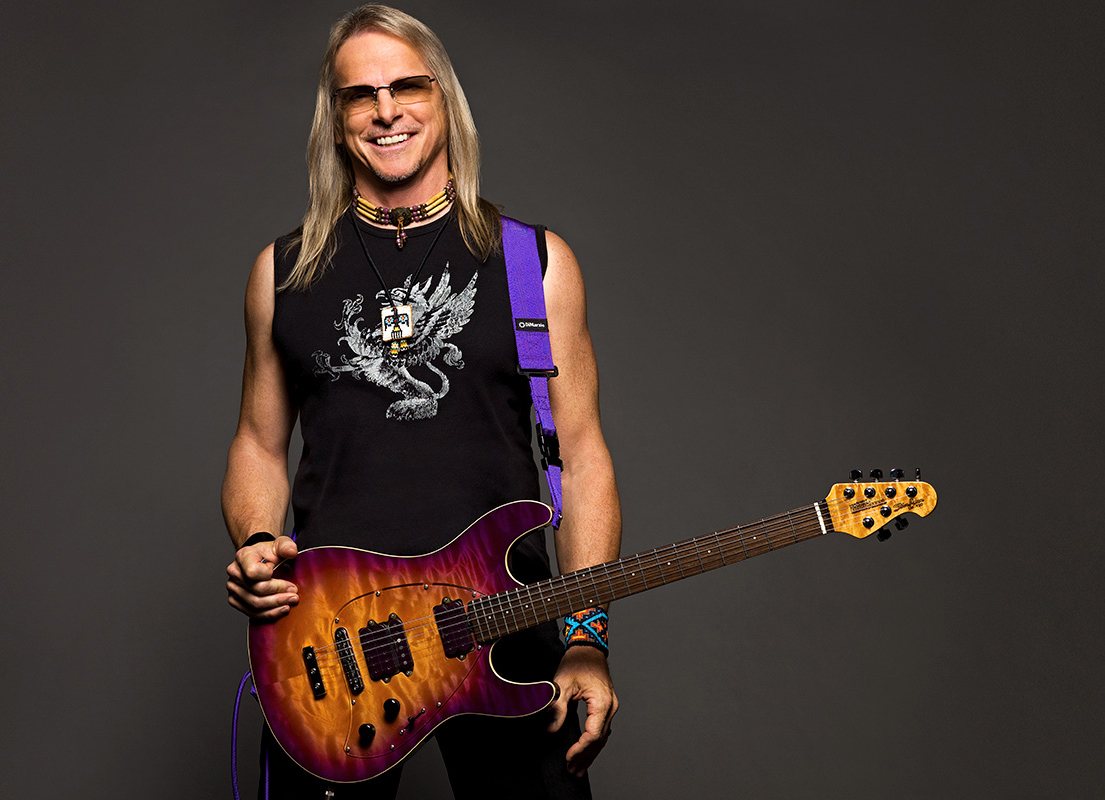 Photo: DiMarzio
Photo: DiMarzio
Steve Morse is one of very few guitarists who have an instantly identifiable sound. His singular approach involves alternate picked arpeggios, creative harmonics and highly-complex chord structures. The combination of that and his prolific and inventive compositions have yielded a storied and diverse 45-year career.
While Morse is capable of going virtually anywhere on his instrument, he’s also focused on serving the music. It’s why he’s Deep Purple’s longest-serving guitarist. He joined in 1994 and remains a core fixture of the group, which just released Whoosh!, Morse’s seventh album with the band and its twenty-first, overall.
Morse began his professional life as a musician with The Dixie Dregs, the revered jazz-rock group that first formed in 1975 in Miami, Florida. Its 10 releases across its intermittent existence remain among the genre’s strongest recordings. In 2018, the group reunited its 1977 lineup featuring Morse, Steve Davidowski, Rod Morgenstein, Allen Sloan, and Andy West for an American tour.
The Steve Morse Band, a jazz-rock power trio, has also existed in parallel with The Dixie Dregs and Deep Purple. It formed in 1983 with Jerry Peek and Rod Morgenstein, and later included Dave LaRue and Van Romaine. As with The Dixie Dregs, its eight releases are infused with myriad influences, including classical, folk and Americana.
Flying Colors is another band Morse currently records and performs with. Also featuring Dave LaRue, Neal Morse, Casey McPherson, and Mike Portnoy, the group has put out three albums of intelligent songcraft infused with complex, yet melodically-focused arrangements and playing. In addition, it has three live recordings to its credit, including its new Third Stage: Live in London release.
Other significant bands Morse has been a part of include Kansas and Living Loud. Between 1985-1989, Morse participated in the former, recording two albums, 1986’s Power and 1988’s In the Spirit of Things. Morse was a core contributor to Kansas’ output, arrangements and performances during this period, with In the Spirit of Things regarded as a late-period highlight.
Living Loud is the brainchild of Ozzy Osbourne classic rhythm section Bob Daisley and Lee Kerslake. Together with Morse and Jimmy Barnes, the quartet came together from 2003-2005 to reinterpret Osbourne tracks Daisley and Kerslake had co-written for Blizzard of Ozz and Diary of a Madman. The band was partly motivated by Osbourne replacing their contributions on the original albums after the two sued him for missing royalty payments. The group recorded a self-titled debut and live album, both combining Osbourne covers with new hard rock material.
Innerviews spoke to Morse on the phone from his home Ocala, Florida, where like every musician during this challenging period, he was contemplating life in the midst of the coronavirus pandemic.
How has the COVID-19 situation affected you?
Well, every day is a surprise, with this whole COVID-19 restructuring of the music business, not to mention the state of the country and the world. Every day you’re waking up to something new.
One thing it’s been good for is forcing a different reality on me. That's one thing I tell people to do—get out of a rut, musically, by forcing yourself into different limitations. For instance, if you’re used to playing in box patterns on guitar, in which you’re doing shapes with your left hand, maybe try playing a melody using only three strings—or even two strings. That forces you to go up and down the neck. And if you’re used to playing electric guitar, try playing more acoustic guitar to come up with different ideas and approaches.
One of my new limitations is suddenly having no gigs and no way to make gigs happen, except for making iPhone videos and sharing them. It’s given me a different perspective. Suddenly, I can say “Let’s go hang out with the whole family on Friday,” because I’m going to be there for a change. Instead of being away on tour all the time, recovering from a tour, or planning for the next tour, now there’s time to catch up on things. In that sense, the situation is good. In another sense, it’s been kind of funny. Because people know I’m home, I get lots of requests to do stuff, including things for friends and family.
Elaborate on what you mean by the restructuring of the music business.
We don’t know if people are going to go to gigs in the same numbers when this is over. There was already a delicate balance between expenses and ticket sales before. People might have looked at a musician and said “That guy’s successful for sure,” when in reality they were on the borderline of whether or not to tour at all, because they couldn’t make the numbers add up. In my case, by the time I pay everybody, get the plane tickets, hotels, equipment, and commissions, there may not be much left. I think a lot less people will be touring after COVID-19. I also think people that do tour will do gigs that are more community-based. They’ll play where they can drive their own vehicle to the gig. Maybe they’ll carry a smaller rig and do solo stuff.
I don’t know what the future’s going to look like, especially when we also know a certain percentage of people will be scared to go to a crowded theater, even when this is over. And when concerts are happening again, I think the ticket-buying population is also going to be very price-conscious in terms of how much they’re willing to pay.
The other part of this is thinking about all the people that don’t get covered by all those government plans that involve printing money. A self-employed person with no employees doesn’t qualify for any of that small business stuff.
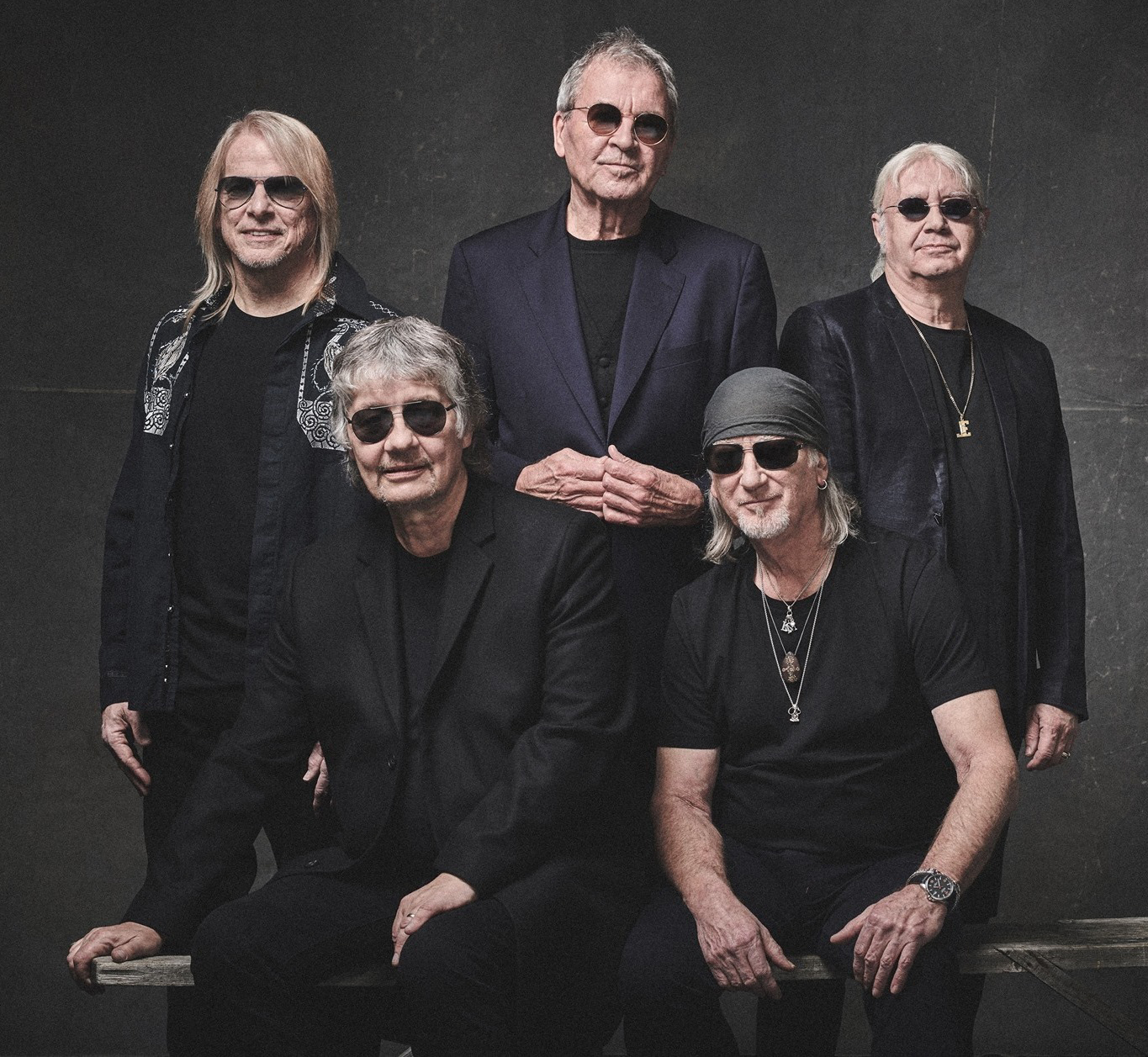 Deep Purple, 2020: Steve Morse, Don Airey, Ian Gillan, Roger Glover, and Ian Paice | Photo: Ben Wolf
Deep Purple, 2020: Steve Morse, Don Airey, Ian Gillan, Roger Glover, and Ian Paice | Photo: Ben Wolf
Deep Purple had plans for a lot of 2020 touring for the new Whoosh! album. How is the band recalibrating?
Well, 2020’s gone. It’s like it never happened. What was supposed to happen in 2020 looks like it’s being rebooked for 2021. We’re going to do a full tour, eventually. After decades of touring, the promoters know us. But after a year-and-a-half of nothing, there are going to be fewer opportunities to play for a while. But musicians are very adaptable. In general, people are very adaptable. Look at all these people finding ways to work from home. It’s awesome if you have a job as a lawyer or you’re with some agency in which you can adjust to working with just a computer and phone.
With Flying Colors, we did a little subscription webinar showing us getting together and doing a writing session online. Necessity is the mother of invention. But I don’t see how anyone—unless they’re computer and marketing geniuses—could come up with a way to make a living doing this. Yet, there are people doing that. I guess the situation is weeding out folks like me who aren’t versatile in that way. I don’t sing. I don’t do cameos like Ron Bumblefoot or Steve Lukather, who are great singers as well.
All in all, it is what it is. Everybody across the board is affected. I worry the most about people who are on the edge of making it—people who don’t know if they can pay their bills and mortgages. They’re feeling a huge amount of stress right now. They already had as much as they could deal with before, and now it’s worse than ever. I feel terrible for all of them. But this is the reality we all face—musicians and everyone else. As a musician, my livelihood is so dependent on the road. And music listeners lose the communal experience of attending those gigs.
What’s your perspective on how Whoosh! builds on Deep Purple's previous two albums Infinite and Now What?!
It’s more of a fun album. Bob Ezrin, to his great credit, addressed the band at the beginning and said “You guys know the drill. No-one’s going to play this on the radio. It’s never going to be a top hit. Let’s just make a record we like and that the people who follow the band will like.” Of course, he’s preaching to the choir. I haven’t made career decisions with the idea that “Oh, people will love this. This will be a mass hit.” My career has always been kind of the opposite. In my case it’s more “That sounds too much like an obvious thing. Let’s not do that.” Purple naturally does stuff that has some point its fans can relate to.
Whoosh! Is a lot like the last album Infinite in that it’s a collection of tunes with a wide variety of styles. It’s got a generally upbeat attitude. We even did a new version of one of the very first things Purple ever recorded back in the ‘60s called "And the Address.” It’s something people would say to each other after somebody made a certain kind of bodily function noise. [laughs] It’s an obscure British joke. So, we re-did the tune with fairly authentic sounds. It’s a little piece of history and I thought it was fitting to do.
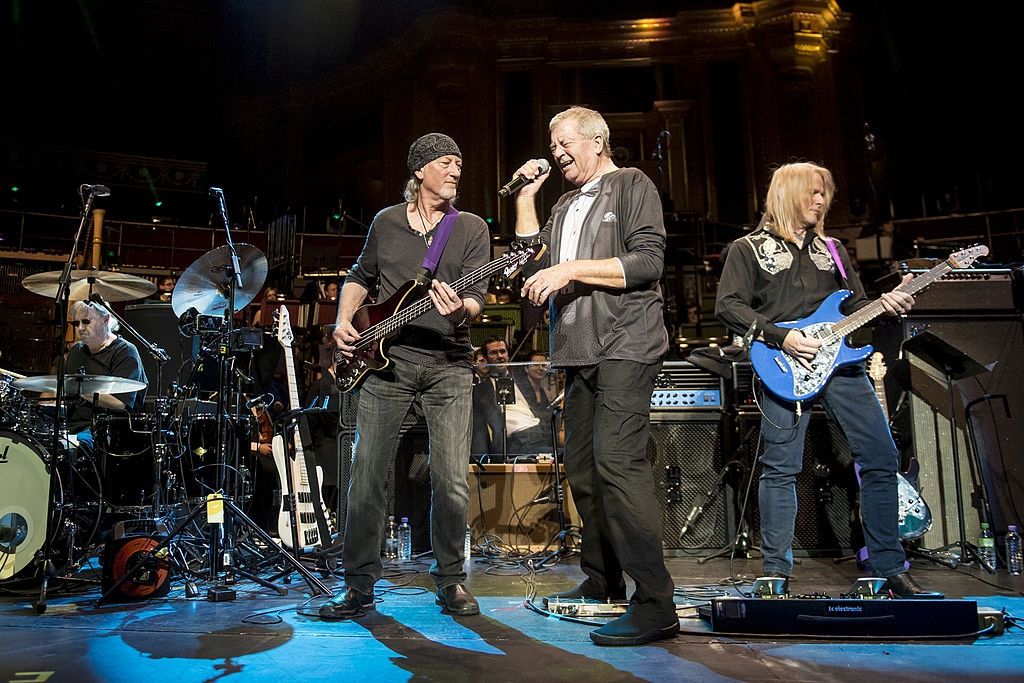 Deep Purple, 2014 | Ian Paice, Roger Glover, Ian Gillan, and Steve Morse | Photo: Ear Music
Deep Purple, 2014 | Ian Paice, Roger Glover, Ian Gillan, and Steve Morse | Photo: Ear Music
Between 2017-2019, Deep Purple was engaged in The Long Goodbye Tour. Is Whoosh! likely to be the final studio album?
I wouldn’t bet on these guys dying before the age of 150, the way they’re going. [laughs] So, I don’t know. I mean, I used to know. I thought Infinite was the last album. I want to be part of the very last Deep Purple album and tour, but I’m not sure I’m going to live long enough. [laughs] We’ll see.
I think the guys went and got some health tune-ups or some kind of vitamins. I don’t know what they did, but they want to keep going. I love the band. I’ve always stayed busy with things like Flying Colors and we did a Dregs reunion tour a couple of years ago. I’m always writing bits for something or other. It’s usually not me that says “You know what? We need to do this whole Deep Purple cycle of writing, recording and touring again.” But here we are. The band’s gung ho on going forward. And I can tell you, after months and months of not playing live, and knowing there won’t be any gigs for a long time, I sure do miss it.
This is the third album in a row Bob Ezrin has produced for Deep Purple. You also worked with him on Kansas’ In the Spirit of Things in 1988. What does he bring to the table that serves the band so effectively?
He’s like the designated chairman of the board when it comes to discussions. He throws in his opinion, but it carries a little bit more weight because he’s done so many great albums. He’s also one of the smartest guys you’ll ever meet in terms of memorizing the complicated details of a tune and what you played within it. He can hear all kinds of possibilities in his head. He’s always willing to jump in there and help you if you can’t come up with an idea you like. But in general, we write on our own and then he comes in and says “Here’s what I like. Here’s what I don’t like.” That’s been helpful to us, because it helps improve the arrangements.
Behind the scenes, when the rest of the band isn’t there, Bob seems to really get a lot out of Ian Gillan. One story I love is when Ian and Roger Glover were talking about lyrics and melodies amongst themselves in the rehearsal room, a voice from across the room, 50 feet away, would go “I’m not liking this.” [laughs] Bob would be looking at his iPad or laptop and typing and look up and tell you what he thinks with that big city, no-nonsense voice he has. But it’s serious enough to definitely make them stop and rethink what they’re doing. It’s also simply frank and inoffensive when he does that. He’ll do that to me too when I’m trying to do a line, melody or solo. If it’s too complicated, he’ll say something like “Morse, save it for your solo album. Give me something solid.” [laughs] He’s sort of like the drill sergeant you love.
As for how he’s changed across the three albums, I think he knows what I’m going to do before I do it now. And he wants me to play more like David Gilmour would and less like I would. In other words, he wants something spectacularly melodic and simple. That’s a huge challenge. What ends up happening is I do what I do and to some extent, I do bend to his wishes. He’ll take out a couple or even several solos. He’ll cut out pieces he thinks sound closer to what he’s envisioning. So lately, I end up with solos that are more clean and simple.
It’s a trust thing. I have to trust that his decisions make the song better. In a band in which everybody’s throwing in ideas—and I throw in a lot of ideas—you can’t be right most of the time. People will have their views. It’s more comfortable for me to just play in my style and relax. That’s what I do. But in a band, you have to take the support role most of the time. Everything I do is based around what’s going to fit the song in the eyes of the producer.
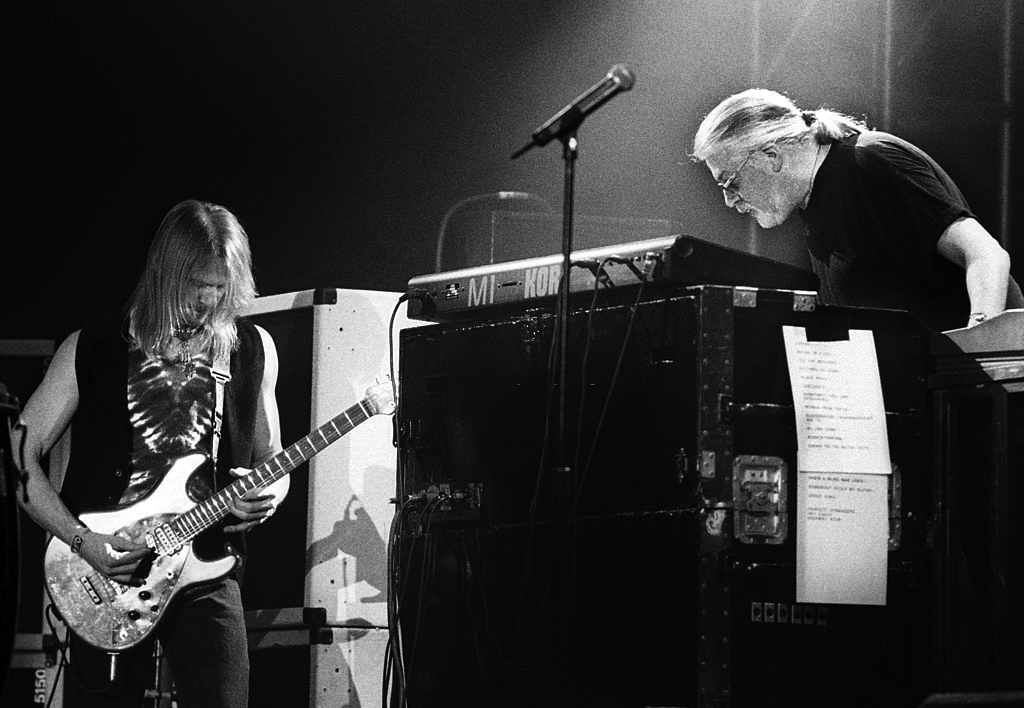 Steve Morse performs with Jon Lord during the 1996 Purpendicular tour | Photo: BMG
Steve Morse performs with Jon Lord during the 1996 Purpendicular tour | Photo: BMG
You’re Deep Purple’s longest-serving guitarist. What contributes to making things work so well?
We have the luxury of good chemistry and that may be luck or it’s just the nature of the other guys. They were all pulled from other groups when they joined the band because they were great musicians. Roger and Ian Gillan were roommates and had a band before Deep Purple. They sort of came as a pair. Ian Paice has always been in every version of the band. Jon Lord was there from the very beginning, too. Don Airey and Jon have some eerie similarities. They both have incredible ears and love to mix styles of music, including classical with rock.
I keep talking about Jon as if he’s still here. Both Don and Jon can improvise like jazz players, which I love. That’s been an important element in keeping things interesting—having such complex possibilities with keyboards. Ian puts that swing in his playing that fits perfectly with rock. I love having those little bits of swing, all the time. It makes everything so comfortable to play.
The guys love to have a good time. They consciously try to avoid strife. They rely on their British behavioral traditions. None of it is written or spoken out loud. It’s just the way it is. There are traditional ways the band addresses and prepares for things. For instance, when we’re leaving the hotel to go for a flight, even though the flight won’t leave without one of us, if you’re even five minutes late, it’s a huge deal. If you’re on time—exactly on time—you’ll find everybody in cars, sitting and waiting for you. That’s why I came up with my famous phrase “In Purple, if you’re on time, you’re late.” [laughs]
So, we have traditions in the band. But everybody respects each other greatly. If you do anything that seems like you’re not respecting the other guys, that causes a breakdown in the mood, which is always a bad thing. And it should be remedied as quickly as possible, but it’s very rare for it to happen.
The secret to this lineup’s longevity is that it’s comfortable to play with, but challenging. They love to give you room to do your own thing, but they rely on you to have respect for the band and its history, and to edit what you do to an appropriate length, so you’re not overdoing your personal thing too much. And as human beings, they generally like to keep a light mood. A half-hour before every gig, there’s always a little section of conversation that shifts to soccer scores and jokes.
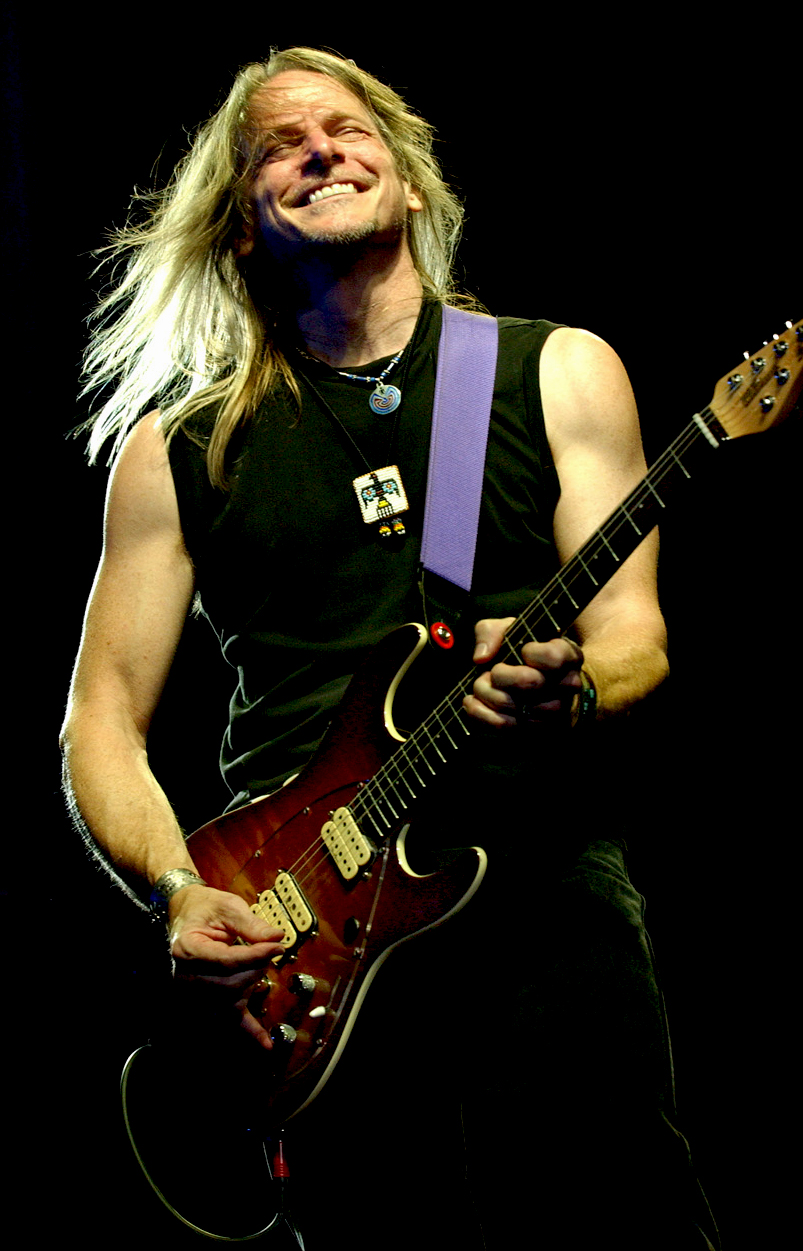 Photo: Bob Mussell
Photo: Bob Mussell
How do you look back at your first album with Deep Purple, 1996’s Purpendicular?
I like it a lot. In fact, it’s my favorite Purple album. It was groundbreaking in every way. When we were making it, I was just kind of tuning up one day, playing this little harmonic idea and noodling around, with the amp off. Roger heard it and then Jon heard him talking about it. He joined in and I started playing through the amp. By the end of the day, we had recorded “Sometimes I Feel Like Screaming." Those kind of organic moments aren’t planned.
Roger’s the guy I talk to the most. He has a real sort of innocence and genuine interest in the idea of “We don’t know what we’re going to get.” You can hear that in the songs “A Touch Away” and “The Aviator” as well, which are fantastic and I love. Of course, the band’s hardcore fans wanted to kill me, because they were doing stuff that was outside of the normal wheelhouse of Deep Purple.
But to me, personally, I thought the album was really cool. I was envisioning how Jimmy Page would play steel guitar or acoustic. You’d also hear mandolins in some of Led Zeppelin’s tunes. I thought Deep Purple’s scope should be broader. So, Purpendicular was an experiment that went “Let’s try anything that sounds good and see where we end up.” For all those reasons, I love Purpendicular.
You’ve been dealing with osteoarthritis in your right wrist. How are you doing these days?
I’m genetically predisposed to having osteoarthritis. For the last 50 years, I’ve been playing with a technique in which I bend my wrist on two different axes, as I twist it, in order to keep the heel of my right hand against the strings so I can create an open space in which every string is muted, except the string I’m playing on. I use two fingers and a thumb, and an arched hand position. It worked great for string skipping, single-note arpeggios and lots of things. It also really improved my accuracy and gave me a different style of playing than most people.
However, playing 10,000 notes a day for 50 years apparently wears out the cartilage between the bones. It destroys the ends of the bones and you get painful inflammation and lose mobility.
I’m developing a strong technique that involves basically not using my wrist anymore. I’m using my arm as one unit for most of my practice, picking from the elbow and changing my grip. There are three different grips I have to use to keep from cramping up or losing strength. I also have a lot of different picks, including experimental picks like bent ones, formed ones, and others in which I put a piece of foam on. I also pick with my fingers sometimes. And for fast picking, I still use alternate picking, but I’m picking more from the elbow, not the wrist. All of these are tools to get through the day, but the osteoarthritis is definitely talking to me.
My left hand is still doing pretty good, but when I play gigs, I use a lot of topical painkiller and technology. I’ve even changed my diet drastically. I’m also looking at getting stem cell therapy. I looked into surgery but didn’t like the alternatives I was offered. So, it’s about trying different things and adapting my techniques.
I still practice every day and always have, so that when I have to do something challenging, I’ll have a better chance of doing it.
Is the COVID-19 break from touring helping your wrist at all?
It doesn’t seem any different. Practicing and getting ready for a tour is just as stressful as doing the tour. It’s not getting any better by not playing gigs. So, I feel like I do need to play these shows while I can, because arthritis is an advancing disease.
Is the possibility you’ll have to stop performing live in the coming years something weighing heavily on you?
Yeah. I take playing live pretty seriously. People go to a lot of trouble to come to a show and pay a lot of money. When they’re in front of me, I know what they’ve gone through to be there. I don’t ever want to be in the position of having someone in the audience say “I should have stayed at home.” That’s not where I want to be. I think it’s going to feel bad when I stop, but better to quit while you’re ahead. The doctors told me “You’ll know when it’s time.”
Reflect on the 2018 Dawn of the Dregs reunion tour.
That tour was my biggest challenge. I wrote almost all of that music when I was in my twenties. Things were just so easy then, but there were still parts of the Dregs set that were hard to play even when I was 20. Now, imagine, with everything going on with me, trying to get ready for that. It was the biggest setup I’ve ever done in terms of trying to get parts mastered that I hadn’t been playing constantly for a long time. Mounting that challenge was huge, but I really, really wanted to do it, because we had the rare opportunity of having an entire early version of the band that we started our recording careers with together. Being able to do a tour with every single person from Free Fall was amazing.
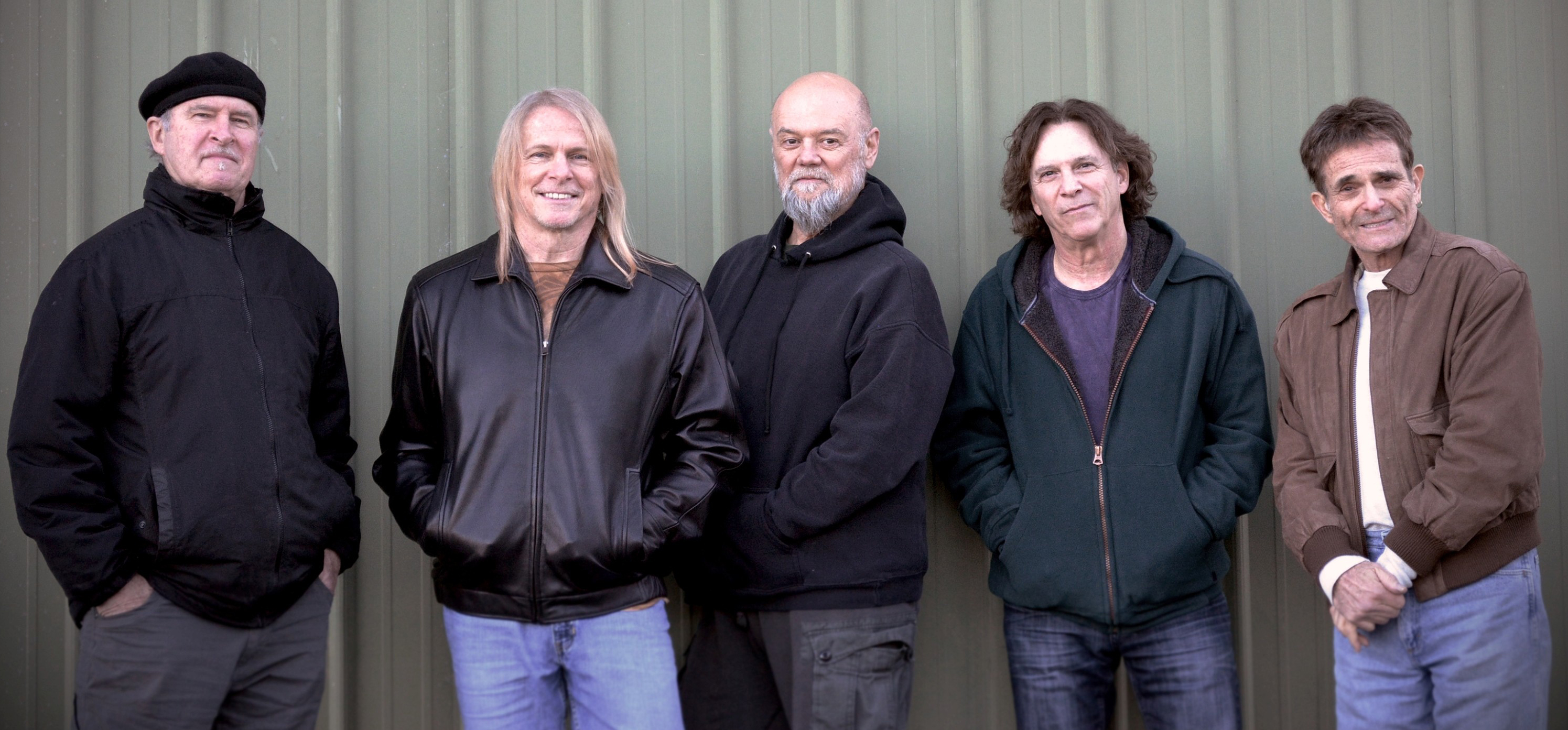 Dixie Dregs, 2018: Steve Davidowski, Steve Morse, Andy West, Rod Morgenstein, and Allen Sloan | Photo: Dixie Dregs
Dixie Dregs, 2018: Steve Davidowski, Steve Morse, Andy West, Rod Morgenstein, and Allen Sloan | Photo: Dixie Dregs
How did you choose the set list for the tour?
We had everyone from Free Fall, so we picked a lot of stuff from that album. There were some songs from What If, even though Steve Davidowski wasn’t on that album. We also did stuff from Night of the Living Dregs that we had in our repertoire or were working on when Steve was with us the first time around. We were mainly choosing from that music. I also wanted to do the song “Day 444” from Unsung Heroes, which we had never played live before. It was a studio production. We took that on as a big challenge and I’m really glad we did.
What do you experience as part of the Dregs that you can't with any other band?
It’s the comfortable history we have. Andy West and I had a connection going back to high school. We were working on music back then. There’s also the shared humor of the band and not fitting in with the music business, but trying to make a living anyway.
Rod Morgenstein is also the nicest guy you’d ever want to meet, as well as being one of the most talented musicians. He has effortless talent. You don’t even have to talk when you’re making music with him. He just knows what to play and what will fit, and he can do it differently from anyone else. It’s just wonderful to be around him. Allen Sloan really loves his parts and is really committed to learning every nuance about every melody. Steve Davidowski also impressed me with his effort and the results he got playing live. By the time we did the Dawn of the Dregs tour, Steve was 75 years-old, carrying this heavy keyboard up and down flights of stairs between the stage and dressing room, so he could warm up between sound check and the gig. He wouldn’t let anyone else carry it for him. He played so well, as did everybody.
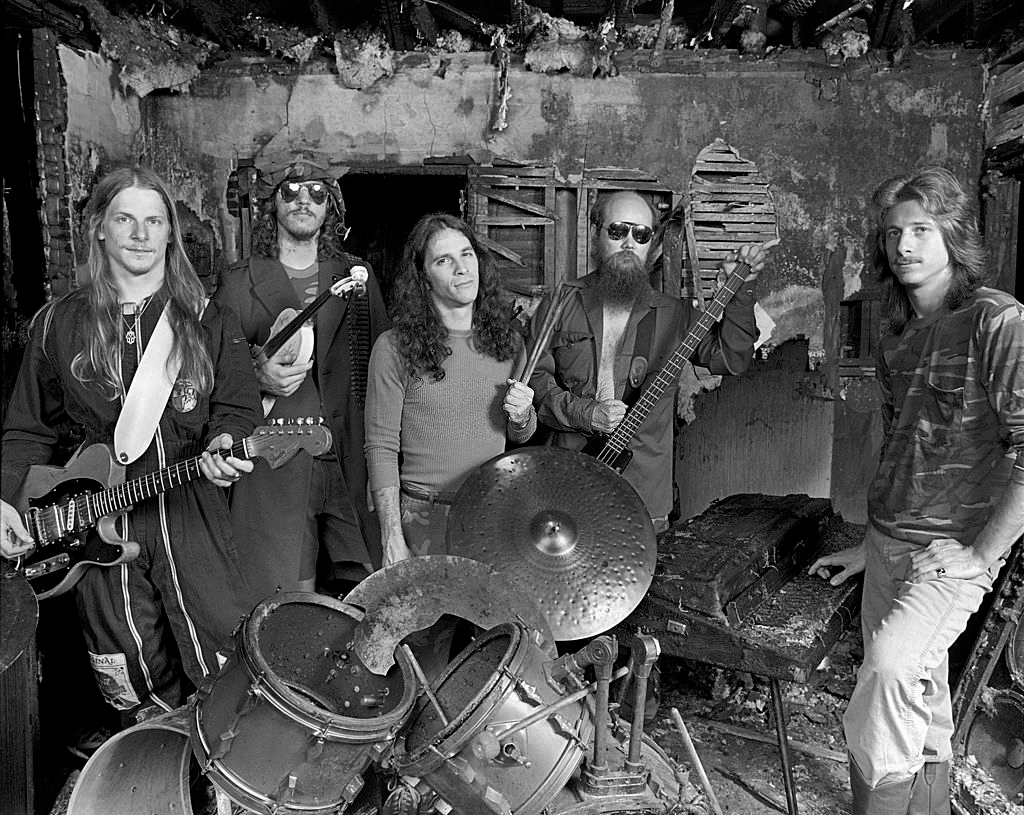 Dixie Dregs, 1981: Steve Morse, Mark O'Connor, Rod Morgenstein, Andy West, and T Lavitz | Photo: Arista Records
Dixie Dregs, 1981: Steve Morse, Mark O'Connor, Rod Morgenstein, Andy West, and T Lavitz | Photo: Arista Records
Do the Dregs have a future beyond the last tour?
I thought it was a great reunion and I was very happy with it. I don’t know how easy it would be to top it, other than to play bigger gigs. The tour checked all the boxes for me, except for maybe having all the other existing members of the other versions of the Dregs there. It would have been nice to have had Jerry Goodman, Dave LaRue, Jordan Rudess, and Mark O’Connor with us. Mark sat in with us during one gig on the last tour. Jimmy Herring did as well. I like the sort of community jamming approach the Dregs have always been open to, as well.
In terms of future shows, I don’t know right now. It’s something you have to plan long in advance. Right now, there’s such a logjam with COVID-19. Whenever we get through this, it’s going to be like people in a line trying to get past a wreck or road construction. When they finally get past it, they’re all going to put their foot on the gas harder than ever to try and make up for lost time.
What’s the status of the Steve Morse Band?
I don’t know, because I’ve sort of lost the impetus to do it. I have so many other outlets for writing now, in which I can have more instruments. With the other projects I do, I can have strings, horns and virtual instruments. With Flying Colors, we have lots of other writers. Same with Purple. It’s a different world for me now. I love playing and working out stuff with Dave LaRue, so I think that’s the way through which anything would happen. It would be us organically getting together, having fun and rekindling things.
I have a great amount of respect for the guys in the band. I really wanted to write to their strengths and that was the main focus in putting those albums together. I think we had a really good touring trio with both versions of the band. They’re wonderful people, so talented and easy to deal with. But life is moving along. Looking back, I do think “My God, what a lucky find being able to play with Jerry Peek, Rod Morgenstein, Dave LaRue, and Van Romaine. These guys also do a lot on their own. The band was a really wonderful setup and I remember it all fondly.
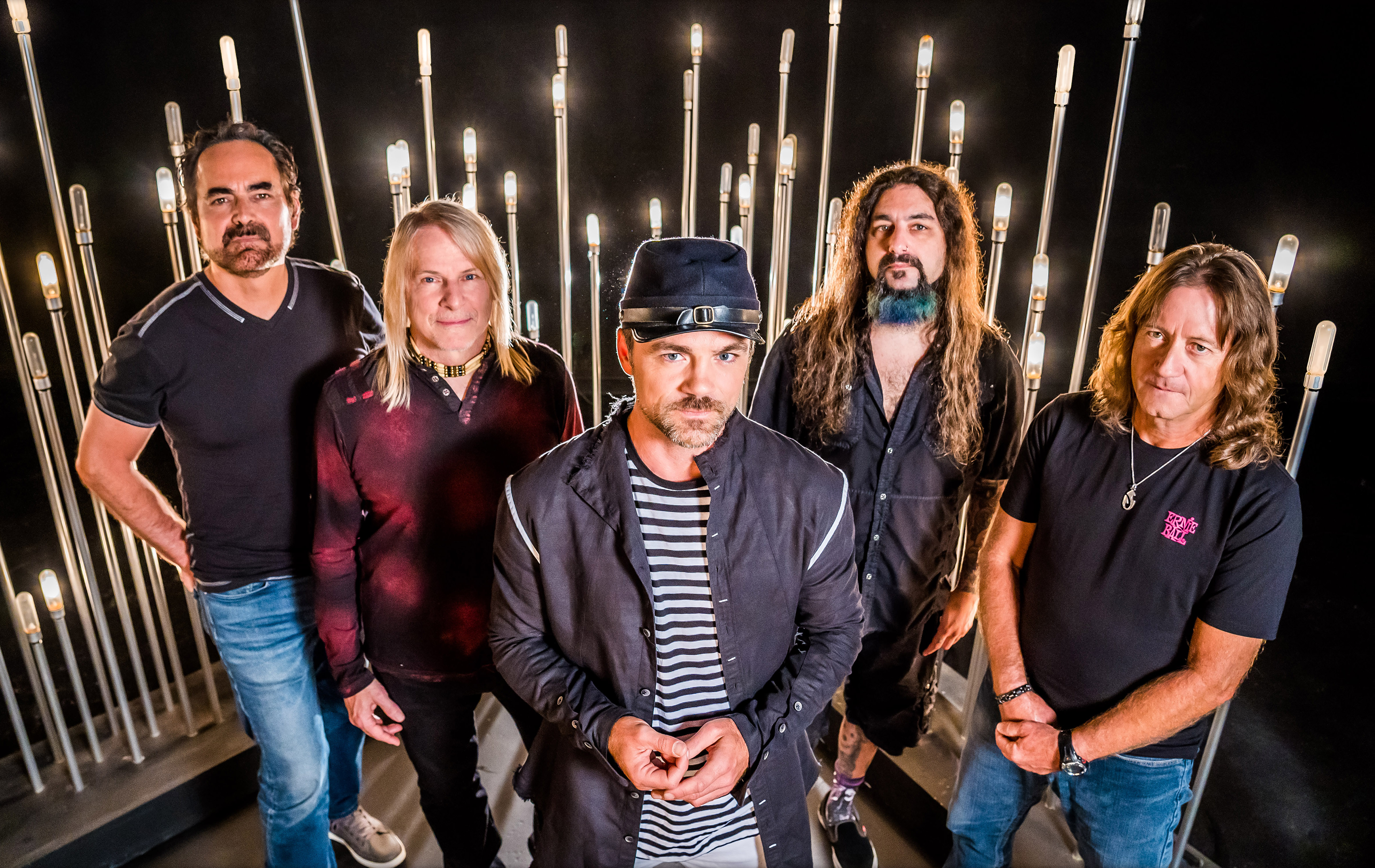 Flying Colors: Neal Morse, Steve Morse, Casey McPherson, Mike Portnoy, and Dave LaRue | Photo: Music Theories
Flying Colors: Neal Morse, Steve Morse, Casey McPherson, Mike Portnoy, and Dave LaRue | Photo: Music Theories
Flying Colors has proven to be a project with legs for you. Describe how it fits into your current framework.
Before Flying Colors, I had done a little bit of cooperative writing in the past, especially with Kansas. With Flying Colors, I’ve had to do the most hustling with my writing ever because Casey McPherson and Neal Morse are so quick with their ideas. Their speed of writing is hard to keep up with. They go 100 miles an hour and it’s a really different environment for me in a good way. I like those kinds of challenges. It’s a similar thing with Purple, but that’s less frantic than Flying Colors. Everything we do with Flying Colors is always under the gun, time-wise, because it’s a part-time thing for everybody.
Peter Collins produced the first Flying Colors album. I understand that was a really positive working relationship for you. Tell me about it.
First of all, he likes guitar. It was great to see him smiling when we did something guitar-based that was instrumental and not necessarily just support for the vocals. He really loved hearing motifs and melodies on guitar. When I tried things like harmonizing or playing baritone guitar, he was always up for it. He was a very pleasant guy to be around and his smile was an indicator of how things were going. The happier he got, the better you were doing.
I think Peter also helped slow the band down, take stock of things and put some pauses in strategic places, too. I would have loved to have him mix the album, but it didn’t exactly work out. For me, it was all positive with him. I never had a moment with Peter in which I thought “Why are we doing this?” I always thought “I’m glad he’s here.” He had such exuberance for the music and positive energy. He celebrated each good thing we came up with.
I’d like to name some albums from across your career that you contributed to and have you tell me the first thing that comes to mind. Let’s start with The Dixie Dregs’ Great Spectacular (1976).
The preparation for that album is the part I liked best. We were together as an ensemble and playing—usually for free—somewhere on campus at the University of Miami or around the city of Miami. The recording itself was stark and unpolished. We had to record it in one night after a long day of school and classes. It was done late at night. We were 19-20 years-old. It wasn’t really a studio. They just put the recording equipment in a live concert hall. We were set up in there with headphones. My amp was in an elevator shaft. The violin, Fender Rhodes and bass went direct. The drums were on stage. It was bizarre. We had to trudge upstairs to the very back where the projectionist would be in the movie theater and do the mix there. So, there was nothing great about the sound. But the preparation was the magic. The songs were in a good place because we had come together as a band.
Dregs’ Unsung Heroes (1981).
Unsung Heroes is the peak of me getting the most out of the band—certainly as a producer. I got a chance to try out all the stuff I learned from Ken Scott on previous albums. So, a lot of work and attention to detail happened. It was a very satisfying project for me.
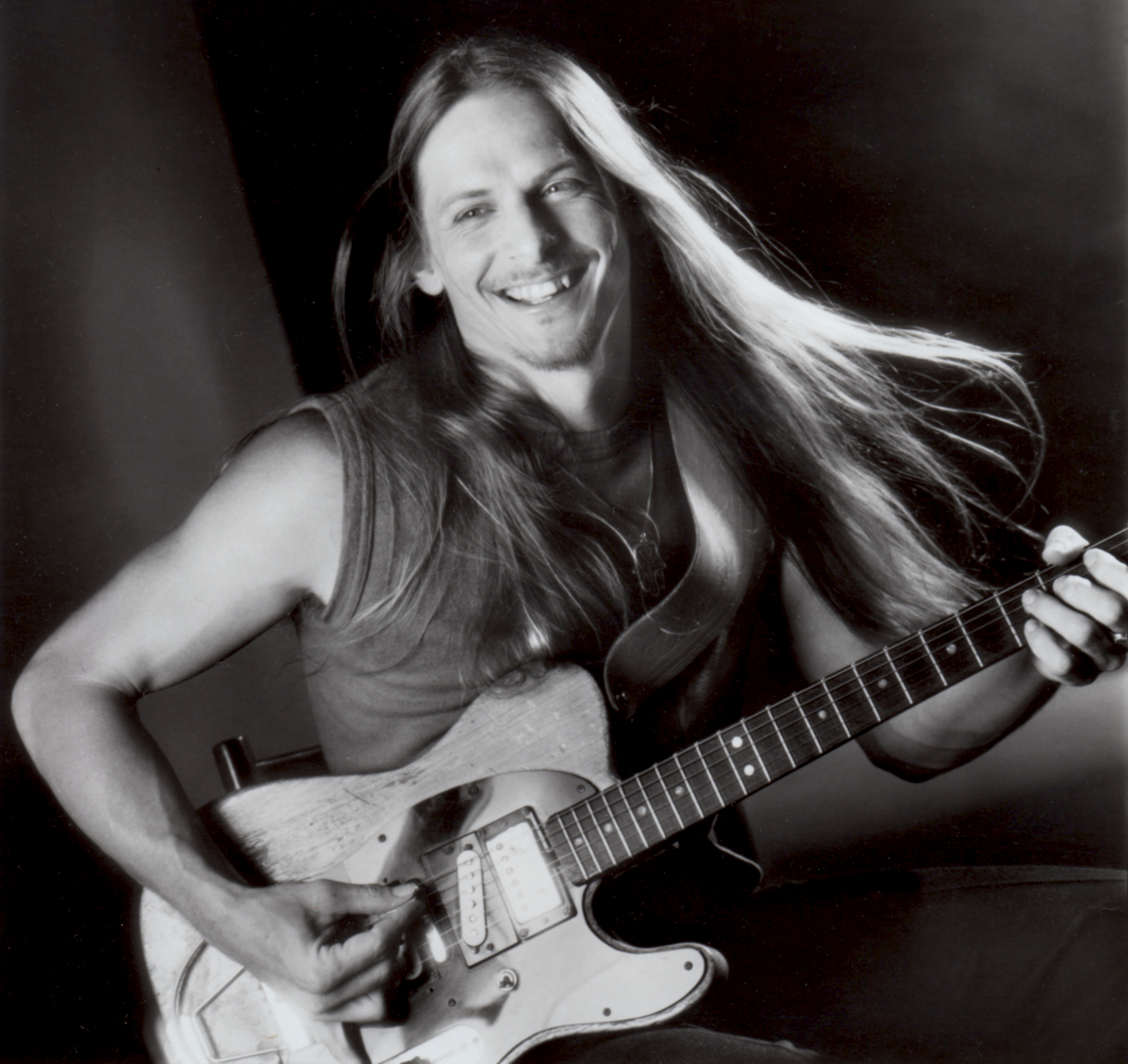 The Introduction photo shoot, 1984 | Photo: Mark Tucker
The Introduction photo shoot, 1984 | Photo: Mark Tucker
Steve Morse Band’s The Introduction (1984).
That was me trying to crawl back into the music business with a touring band. Thank God Rod agreed to do it, as well as Jerry Peek from a band called 3PM. He was the P in 3PM. So, we had three guys all willing to set a time to rehearse and play gigs to get ready for the recording session. The Morris brothers down in Tampa let us use Morrisound Studios very, very affordably. They bent over backwards and gave me a great deal. It cost us very little to make the record, but it took time. It was aptly named. “Here’s my band. Now, this is what I’m doing. This is the introduction.”
Triumph’s Surveillance (1987).
Being invited to be on a couple of tracks on that album out of the clear blue was a really big honor. I think it was all Rik Emmett’s doing. He invited me to do an event called Night of a Thousand Guitars in Toronto, with players from all over Canada and some from the US there.
I love Rik. He’s so full of talent and positive energy. There are people who can organize festivals, group get togethers and parties, and are just natural entertainers. He’s one of those people. I’m obviously not. I’m not a natural entertainer. I’m more of a writer that plays gigs.
I really enjoyed working with Rik. We also played a duet version of the Dregs’ “Up in the Air” live on a Canadian TV show during one of my trips to Toronto. He learned the parts and it was “Here we go. Everybody’s watching. No second takes.” He did an excellent job.
Kansas’ In the Spirit of Things (1988).
I thought there was some good stuff on that album. “Bells of Saint James” is on it, which is one of my favorite Kansas tunes. Some of the moody stuff I didn’t quite relate to as much, but I liked the upbeat stuff. I loved having Bob Ezrin there. He’s always such a challenge, in a good way, because he doesn’t accept the status quo. He pushes me and we joke around with a lot of dry humor. Writing-wise, that album didn’t happen as easily as Power, but because Bob was there, I think it turned into a good product.
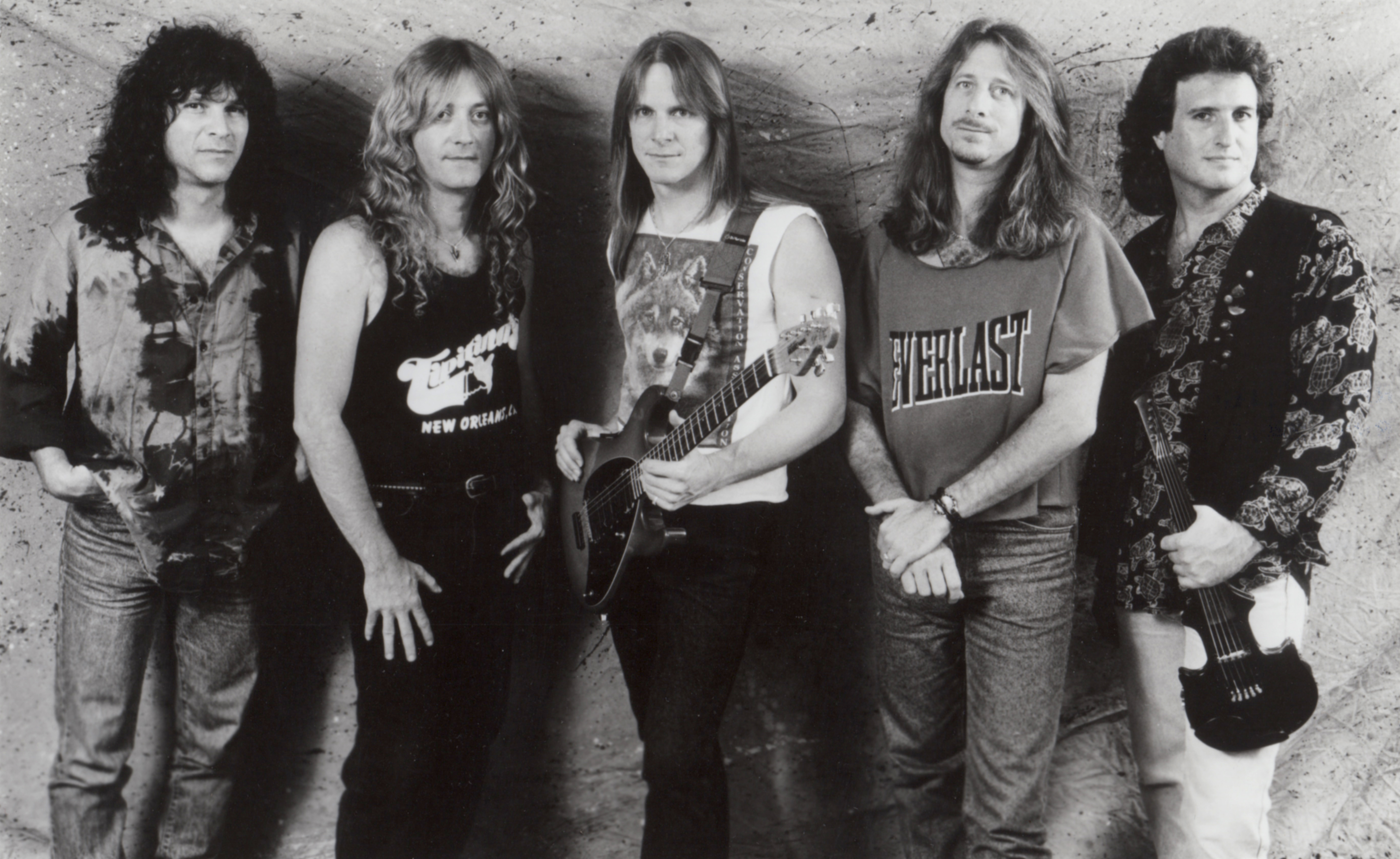 Dixie Dregs, 1992: Rod Morgenstein, Dave LaRue, Steve Morse, T Lavitz, and Jerry Goodman | Photo: Allan Youngblood
Dixie Dregs, 1992: Rod Morgenstein, Dave LaRue, Steve Morse, T Lavitz, and Jerry Goodman | Photo: Allan Youngblood
Dixie Dregs’ Bring 'Em Back Alive (1992).
We recorded that in Atlanta at two shows. It was a lot of work, but I enjoyed making it very much, including mixing it. My favorite memory of that is my son being at crawling age. We had moved to Florida and were in a new house. The studio wasn’t built yet. The studio was in the airplane hangar and I was mixing in the garage. I’d set up my machines and a whole mixing area in the garage.
My son was with me when making it and I loved that. He was a very bright and inquisitive toddler. He loved watching the lights on the tape machine and how flipping a switch would make them change from green to red. Once, while I was setting up a bounce to put a reverb effect on something, he reached the tape recorder and put it into record, and it changed lights. He did it with precision—all eight tracks. So, when I went to do the bounce, instead of bouncing to track one, whatever I was doing went to all the bottom tracks, including some of the drums, which got erased for a few seconds. I stopped the machine as soon as I heard something was wrong, but a chunk of the drums were taken out when that happened.
So, of course, I can’t be mad at my little boy. I gave him something else to do. I showed him how to put wire ties on a guitar stand. That was his task. He covered the guitar stand with them. But it took me hours with a two-track machine to find a suitable replacement for those few seconds of missing drums and fly them in, and sync them up by trial and error. So, somewhere on that album, the drums are gone and flown in using some early digital editing technology.
Michael Manring's Thonk (1994).
It was a surprise to be invited to do that because Michael was from another part of the music business that was more celebrated and welcomed by the media. I was surprised he wanted to have a weird guy like me put his music into a different place. But musicians are very flexible and adaptable. He turned out to be wonderful to work with and very inspiring to be around. I have nothing but good things to say about him.
Living Loud’s self-titled debut (2004).
I loved that. Lee Kerslake, Bob Daisley and I worked together as a trio for most of the writing and arranging. Near the end, we got Jimmy Barnes to come over and he sat down and wrote lyrics without even trying. He’s such a good writer. Lee and Bob were amazing. Bob was a natural producer, so he was a little hard to please. He got more out of me as a result. Lee was just full of melodies. He could whistle them.
Living Loud came out of them wanting to record some of their songs they had written with Ozzy Osbourne they didn’t get any credit for. The unfortunate side of that is it led me to playing songs that Randy Rhoads had done. Randy did such a great job on the originals. It really, really brought out the haters. People said “What’s Morse trying to do? That doesn’t sound like Randy at all.” Bob explained what they wanted to do as “Let’s do it our way. Let’s re-do the songs.” Everybody thought we were trying to do copy versions of the Ozzy recordings, because Bob and Lee were taken off some of them as some kind of payback for insisting on getting credit.
It seemed like a good cause, but I said “I don‘t want to do something where I’m just doing Randy Rhoads’ parts.” They said “We agree, just do it your way.” I said “Well, that sounds better. What about some original tunes?” They agreed. So, we did one original song for every Ozzy cover tune. It turned out to be one of my favorite albums I’ve done. The sheer amount of talent working with those guys was eye-opening. Don Airey was also on the record as a studio musician and sounded fantastic.
We ended up playing two gigs and that was it. But they were great gigs.
T Lavitz’s School of the Arts (2007).
T was so talented and his talent was so relaxed. It was very enjoyable to work with him on things he initiated or that he would approve. He had been having to deal with me for so many years. I enjoyed turning that around and trying to support him. That was cool. I think I played clean electric on that album. Writing with him was very natural. I felt less pressure because he made the calls. I could just react musically, without having to consider anything else.
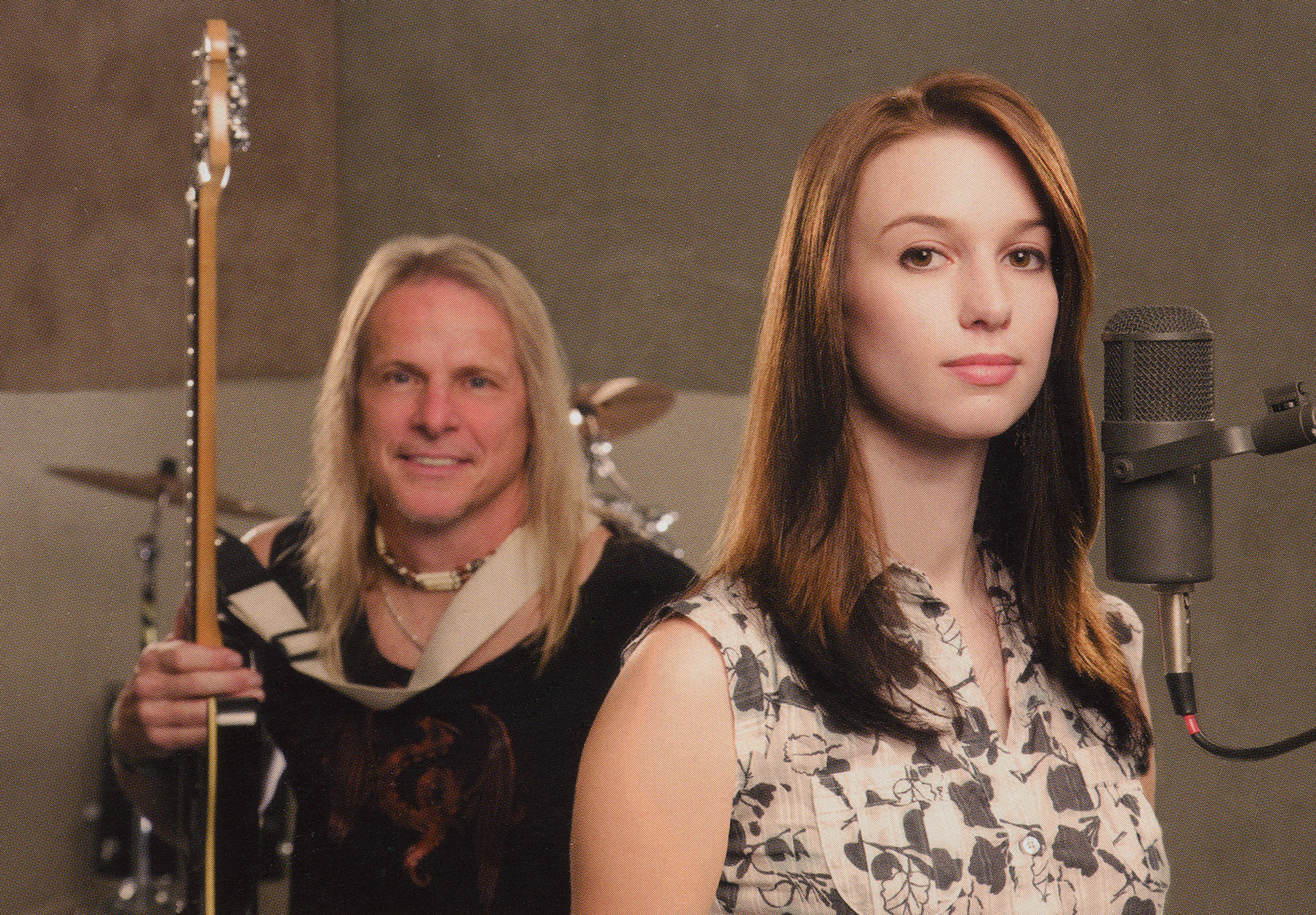 Steve Morse and Sarah Spencer, 2010 | Photo: Jonpaul Douglass
Steve Morse and Sarah Spencer, 2010 | Photo: Jonpaul Douglass
Angelfire, your duo album with Sarah Spencer (2010).
That started when a friend, who’s a guitar player and a doctor, said “Can you give my family some advice? Our daughter wants to be a singer.” I said “I don’t know. I’ve got to hear her sing, first.” He brought over some recordings and I said “Oh, she’s got a great voice.” Sarah’s voice is a really pure voice that’s not full of attitude. It’s beautiful.
I said “I like this. I’d like to write some stuff for Sarah, actually.” So, over the next couple of years, we’d get together to write and record. It was my idea of music that was relaxing for me to listen to. Of course, I was never thinking about what the music industry wants. It’s not country. It’s not mainstream dance music. It’s not any of that. But I thought it was cool, because it was something different. Sarah’s an amazing talent.
You were the opening act for Joe Zawinul’s 1986 Dialects tour. Tell me about that experience and what it meant to you.
Jaco Pastorius was a friend. He was someone I knew in Miami when I was attending the University of Miami’s School of Music. One of the highlights of my time there was going to his place and jamming with him. When he joined Weather Report, it became one of my favorite bands.
Getting the opportunity to tour with Joe Zawinul was really intense. I decided to do just do my thing—what was appropriate for me, and not try to be closer to what he was doing. I had a good amount of variety in my set. It was like “Here’s a piece of music I’ve written for classical guitar. Now, here’s another one with me jamming over a loop.” I was doing that before I met Joe. It turned out to be a neat mix.
I have great respect for Joe. He was super easy to work with and be around. We were kind of separate on tour. I did my thing and he did his thing, but I think it worked well for the audience.
The highlight of the tour was playing Carnegie Hall. Peter Frampton came by and did a duet with me on one song. He did a great job and took it seriously. He’s a very talented guy. People know him for singing songs and playing the hits, but they forget that if you give him an instrumental job, he can nail it.
Reflect on your friendship with Jaco Pastorius.
He ended up going through a real bad phase, but he was very coherent and sincere with me back when we were in school. He had so much energy. He literally couldn’t play it off. If he was in a band and they did a gig with five or six sets a night, that still wasn’t enough for him. He was an absolute powerhouse and he had this natural energy that infected everyone around him. He was a lot of fun.
One time, he sat in with the Dregs and started playing a solo. We hadn’t planned on that or anything. It was during the end of our set. Jaco just kept going on and on and on until we finally put down our instruments and walked off stage. And then he just kept on playing! [laughs] That was Jaco. He was into his thing and he couldn’t stop playing.
When I jammed with Jaco, he was hard to keep up with. He would fly in and keep changing the starting point of what we were doing, but I enjoyed being around such an amazing talent.
Jaco used to always give me ideas for the Dregs. Once, he said “Here’s a thing I think you guys would be great at doing.” I said, “Jaco, we don’t have horns.” He replied “Yeah, but it’s just that one part. You can do it.” A lot of his ideas didn’t fit us. He’d often give us horn charts and stuff to play, but we never did. I said “Look, I’m just doing my thing with this, but I appreciate it.”
I really hated seeing him lose his perspective and kind of go overboard. I hate what happened to him. It’s horrible. It’s something I’m sure could have been straightened out with some kind of prescription—something to mellow him out a little bit. He was an uncontainable force. He literally had too much to say to the world. He was such an incredible player when he was in a band. Nobody could see him play and not just start smiling.
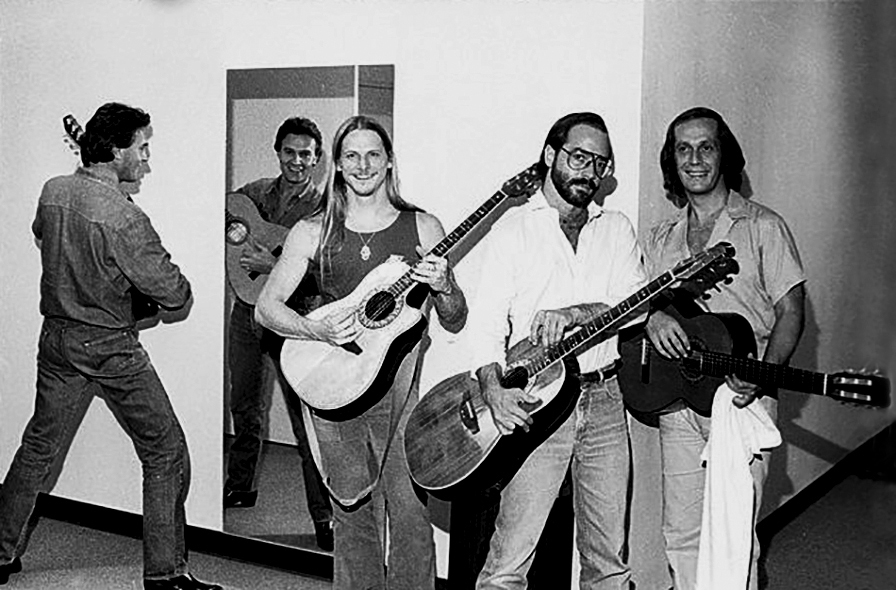 John McLaughlin, Steve Morse, Al Di Meola, and Paco de Lucia, 1983 | Photo: Philips
John McLaughlin, Steve Morse, Al Di Meola, and Paco de Lucia, 1983 | Photo: Philips
Another major opening slot for you was touring with John McLaughlin, Al Di Meola and Paco de Lucia in 1983. What was that like?
That was a huge deal for me. Originally, I was going to replace Al, because he couldn’t do a tour in Australia. I had played with them as a trio in rehearsals. Then, at the last minute, whatever needed to be worked out was worked out, and he was doing the tour. Instead of firing me after all the work I’d done to get ready, they said “Why don’t you open for us?” And then at the end of the show, we’d all play on the same song and trade off between the four of us. That was super intense. It was really good for me in terms of upping my confidence. John McLaughlin is one of my all-time heroes. Obviously anyone that listens to Mahavishnu Orchestra and the Dregs knows there’s a lot of influence from that band on the Dregs.
You’ve been outspoken in your support for having Native American communities better cared for by the government and society as a whole. Tell me about your commitment to them.
I’m an outsider looking in, but with the history America has, there are parts that even as a kid made me feel uncomfortable. I’d think “How could we do that? How was it possible? How can we love our country and still do things to people that are horribly unjust?”
In my old age, I’ve come to realize written history isn’t always accurate and doesn’t always tell the whole story. Bad things have happened to entire cultures and civilizations. Right now, the country is extremely aware of what happened to the people and cultures from Africa. The indigenous people of this country also have a lot of stories.
Big government doesn't always do the right thing when it comes to trying to change how and where people live. We all should show the most respect possible for each other. People should work things out, together. As I travel the world, I see it for myself. People can work things out between them a lot better than government edicts can.
I got to know a family and an elder woman that were being displaced because of a government change. It had something to do with mineral rights underneath her land. Her whole way of life was being taken away. I did a benefit for them and learned a lot about the situation. I also was partners with a guy making holistic vitamins, and he had a medicine woman who was also a doctor formulating the supplements. I was taking them. I liked them a lot and thought they were beneficial.
That’s how I got more into this stuff. We have a little place out in New Mexico that we go out to. We enjoy interacting with the native people. We love the native cooking. I go out of my way to find places that serve Navajo-style food.
In general, I feel we need to watch what we do, and tread more lightly and respectfully as a society.
How does spirituality inform your music and life?
My father was a minister and I was brought up as a Presbyterian. I’m still a non-denominational Christian, but I am very tolerant of other people’s beliefs. I believe we’re all taught what we’re taught and that bowing in the presence of God makes us better people—and certainly better when we deal with other people. It’s important to not worship people as much, but rather bow to the presence and creations of God, and follow the good teachings. This works for a lot of different religions.
My main man is Jesus, because I was raised that way. He was a man of tolerance according to scripture and was slow to anger. Those are wonderful things to emulate.
When it comes to music, it’s a universal language that reaches across all cultures. If you play from the heart and play something moving, it’s most likely going to be moving for people in other cultures. You have to play from your spirit core. If you do that, you’ll reach more people. You’ll find more common ground and more acceptance.
Special thanks to Brian Moritz.